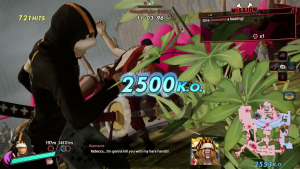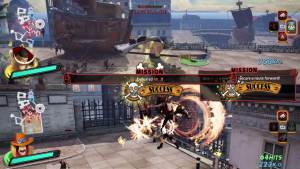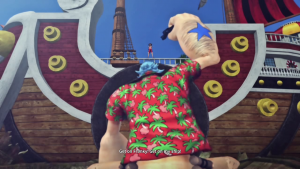For the better part of twenty-plus years, Monkey D. Luffy & his swashbuckling crew have sailed the seven seas in search of the long-lauded One Piece treasure. Luffy’s adventures became more than just a popular manga & anime series – “One Piece” is embedded in the modern pop culture zeitgeist. From cosplay inspiration to people simply quoting one of the insane amount of memorable characters spread across multiple arcs, “One Piece” is, undeniably, a treasure within itself. Thanks to the minds behind the “Dynasty Warriors” games, “One Piece” fans who just so happen to be gamers have had the opportunity to experience a digitized version of Luffy’s story thus far across three games. Though I hadn’t played the previous “Pirate Warriors” offerings, I had taken some time with earlier “Dynasty Warriors” games and had a good idea of what I was getting myself into with this most recent adaptation.
Did I Complete “One Piece: Pirate Warriors 4”?
Like many a musou game before it, “Pirate Warriors 4” is filled to the brim with enemies to conquer across multiple maps while telling the game’s plot via cutscenes both dynamic & static. “Pirate Warriors” doesn’t shake up the formula, providing a campaign via the “Dramatic Log” that took yours truly a little over eighteen hours to complete. To ensure players have more to do before, during or after finishing “Dramatic Log” are two extra modes both open for co-op play: “Free Roam Log” so players can experience the story missions without the plot playing out, and “Treasure Log” provides upwards of 100 randomized maps featuring different victory stipulations compared to its counterparts. I spent a few hours in “Treasure Log” to play around with some of the more eccentric characters as well as took part in some local co-op play; yet the grind for full achievement completion is probably out of the question for the time being thanks to some of the more time-draining requirements such as attaining 100 million berries and finishing the hefty “Treasure Log”.
Did “One Piece: Pirate Warriors 4” Live Up to the Hype?
Like many “Warriors” game before it, “Pirate Warriors 4” features a relatively simple battle system with the player being able to pull off auto combos by hitting the “Normal Attack” button. At the conclusion of each character’s base combo, the player can tap the “Charge Attack” button for a devastating physical exclamation point. Each playable character has four special maneuvers that regenerate after usage. These special attacks are not only devastating, they also have the ability to boost a character’s power & speed if one of the character’s available boosting abilities is initiated. Utilizing these special attacks haphazardly isn’t wise as enemies can still move around if not stunned and avoid the incoming attack. There are a couple of new combat implementations in “Warriors 4” including the ability to dash – a stamina-draining maneuver that can do minor damage to opponents while knocking them backward. Air juggling is another ability every character has in their arsenal. During a normal combo, the player can tap the “Jump” button to propel the surrounding enemies upward for a combo extension that automatically stuns them.
With a plethora of characters at the player’s disposal, the developers did a masterful job ensuring each one plays differently thanks to both the character’s aesthetics tying into their other adaptation counterparts & the base style of each character (“Power”, “Sky”, “Style”, and “Technique”). While a “Power” style character may move slower, they can take & dish out more damage than the average “Sky” fighter who makes up for their lack of strength by extending air juggle combos into special attacks. Upgrading these characters & their styles ties into extensive skill trees/“Maps”. The “Beginning Map” is shared across all the characters while each character has two individual “Maps” with the resources for upgrades coming from completed battles including rare coins attained via certain boss battles or using a character the coin is associated with for a mission. The game noticeably displays a character’s progression as they will hit harder, last longer & have more stamina when comparing upgraded characters to the once recently added to the roster. Also connected to upgrades are passive abilities that can be slotted into the playable characters before a battle including gaining power boosts after defeating a certain amount of enemies or making it easier to attain berries. The level of customization & character offerings is great and makes testing the waters with what’s available that much more enjoyable.
On the opposite end of the spectrum in regards to variety are the enemies. Most of the enemy hordes can be destroyed with a few hits; depleting the bar overhead signaling the enemy’s loss of control in that map’s portion. When the aforementioned bar empties a “Leader” appears sporting more health and armor than the underlings. There are also “Commanders” that would be considered a little more difficult than the average enemy, but sporting weaker armor & health than the “Leaders”. Boss battles are mostly similar to one another with a few being unique such as Hawkins having “lives” connected to certain “Commanders”; making the slaughtering of these elite soldiers first priority so Hawkins doesn’t regenerate all of his health after apparently being conquered.
Mission completion brings the combat & exploration together. Usually the way to advance a mission is by overcoming a plethora of enemies and capturing territories (all while destroying surrounding buildings in grand fashion). Some missions later in the modes ask more from the player such as protecting retreating allies or reaching a character near death. Sub-Missions will pop-up from time to time usually assisting in capturing an area on the map or even being helpful to the main mission such as revealing the specific “Commanders” helping Hawkins.
“Warriors 4” doesn’t shake things up too much in regards to mission presentation compared to other musou games, but does a great job at maintaining status quo. The story, however, doesn’t do well when taking into account new fans or the unaware could be playing this sequel. With six worlds available, five major arcs in the manga are covered in the most abridged way possible; leaving out key moments and not fully explaining certain relationships. The sixth and final arc isn’t canon and comes across more as fan fiction than anything else in the presentation. Co-op play is perfectly fine with the ability for both local and online play. Locally, co-op is split screen while online allows for up to four players to work alongside each other at the same time. In regards to online co-op there are some special missions that are available that don’t necessarily add much to the overall offering.
There are some bigger presentation problems than underwhelming storytelling. The camera can become nothing short of a hindrance at various times. Larger enemies will actually become invisible if it clashes with the camera movement; making it impossible to properly direct the next special maneuver. The lock-on system focuses on the most powerful foe onscreen, but isn’t reliable as the camera swoops way too much. Another map issue is the 2D nature of the smallish overhead map though every map works on a 3D plane that, at times, can make it difficult to figure out the right path. The HUD during missions is cluttered at best with mission notifications appearing on the middle of the screen while character communication happens frequently at the screen’s bottom. Easily the biggest issue in regards to gameplay is the lack of mission checkpoints. With a majority of the missions lasting upwards of fifteen to twenty minutes, a failed mission or fallen protagonist will mean restarting the mission while losing experience & upgrade items. Loading times are also long-winded during the initial screens, before picking a character & that character’s load-out; though frame rates were stable throughout my experience without a single crash.
“Pirate Warriors 4” doesn’t reinvent the figurative wheel by capitalizing on the absurd nature of its source material while providing a fast, frenetic, and, most importantly, fun combat system helped by the available modes & co-op options. Unfortunately, the storytelling and several profound gameplay flaws prevents “Pirate Warriors 4” from becoming the crème de la crème of musou experiences.
Should You Play “One Piece: Pirate Warriors 4”?
Musou veterans will know exactly what to expect – a fast & furious combat system reveling in the whacky nature of “One Piece”. The storytelling is not for the new or partially uninitiated fan looking to dip their toe into the series and the “Warriors” genre. The biggest knock against the game beyond its various flaws like lacking checkpoints and camera issues is the price. Given a AAA price tag at launch, “Pirate Warriors 4” still doesn’t feel worth the asking price even with everything it brings to the table. Fans of the musou genre and “One Piece” in general will get a kick out of this one, but will find themselves a lot more satisfied with the experience if they pick it up while it’s on sale. New fans & those not aware of the genre’s offerings should definitely rent it first before deciding whether or not it would be worth a purchase. No matter what you do, always be kind to one another and give them their underwear back when you want to recruit them for your scurvy-riddled crew.







